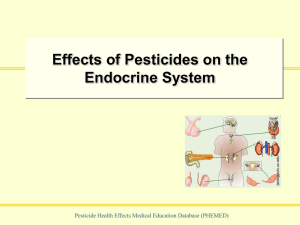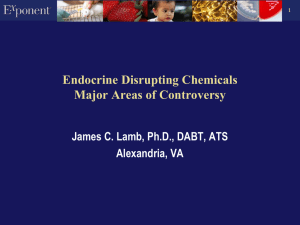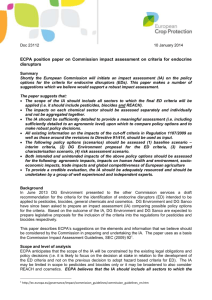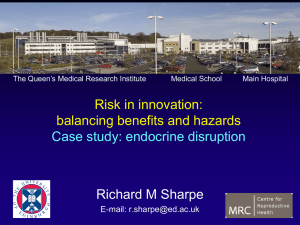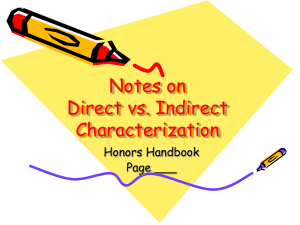(Griesser) ( 1.1Mb) - European Crop Protection Association
advertisement
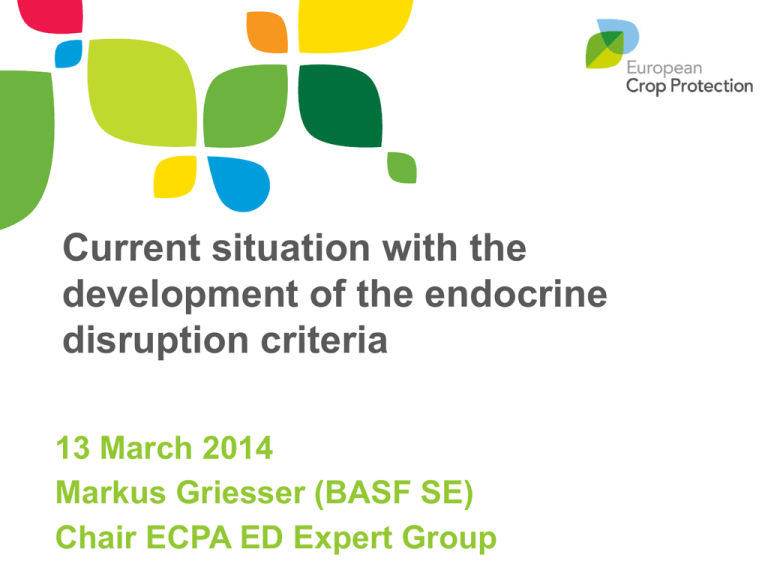
Current situation with the development of the endocrine disruption criteria 13 March 2014 Markus Griesser (BASF SE) Chair ECPA ED Expert Group Outline Introduction Proposals for ED criteria and further scientific input State of play and way forward Potential impact on agriculture, innovation and trade Summary Definition WHO/IPCS (2002) „An endocrine disruptor is an exogenous substance or mixture that alters function(s) of the endocrine system and consequently causes adverse effects in an intact organism, or ist progeny, or (sub)populations.“ Widely accepted definition, but… The WHO definition is not a regulatory definition! What is the concern about? WHO/ UNEP report 2012 – Many ED-related diseases are on the rise – Human and wildlife populations are exposed to EDCs – Numerous laboratory studies support the idea that chemical exposures contribute to endocrine disorders – Internationally agreed and validated test methods capture only a limited range of the known spectrum of ED effects The 2012 report raises a global concern on EDCs Critique of the WHO report Critical review by Jim Lamb et al (February 2014) – Summary is not a true representation of the main report – Disease trends are attributed to ED without evidence of their causes or discussion of other possible factors – Dose-response and potency are addressed poorly The report does not provide a balanced perspective and is not an accurate reflection of the state of the science on endocrine disrupters ED regulation in the EU Horizontal ED criteria for all sectors Pesticides Biocides REACH Hazard-based cut-off Hazard-based cut-off ED may be SVHC Limited derogations possible Derogations possible Authorisation based on risk assessment ED criteria: proposal by December 2013 ED criteria: adoption by December 2013 ED criteria: no legal requirements Harmonized criteria, but consequences differ 6 ED in EU pesticides legislation Regulation 1107/2009 • Annex II, Article 3.6.5 (Human Health) – “An active substance, safener or synergist shall only be approved if …. it is not considered to have endocrine disrupting properties that may cause adverse effect in humans, unless the exposure … is negligible, that is, the product is used in closed systems or in other conditions excluding contact with humans and where residues of the active substance, safener or synergist concerned on food and feed do not exceed the default value set in accordance with … Regulation (EC) No 396/2005.” • Annex II, Article 3.8.2 (Environment) – “An active substance, safener or synergist shall only be approved if … it is not considered to have endocrine disrupting properties that may cause adverse effects on non-target organisms unless the exposure of non-target organisms … is negligible.” No criteria defined despite legislative deadline ED in EU pesticides legislation Interim criteria • Pending the adoption of these criteria, substances that are or have to be classified, in accordance with the provisions of Regulation (EC) No 1272/2008, as carcinogenic category 2 and toxic for reproduction category 2, shall be considered to have endocrine disrupting properties. – Interim criteria not scientifically justified (not all substances classified as C2 and R2 are automatically endocrine disrupters) – No interim criteria and legislative deadline for the environment – Interim criteria are beeing applied for the CfS list – Some member states want to apply interim criteria for AIR2 – ECPA position: interim criteria should not be applied for regulatory decision making Provision is a poor substitute for scientific criteria Outline Introduction Proposals for ED criteria and further scientific input State of play and way forward Potential impact on agriculture, innovation and trade Summary Industry proposal to regulate ED First detailed proposal for ED criteria Original work published in 2009 as technical report Detailed assessment scheme to identify EDs of regulatory concern for human health and wildlife In 2013, the American Society of Toxicology (SOT) awarded it “Best Published Paper Advancing the Science of Risk Assessment” Source:R. Bars et al. Regulatory Toxicology and Pharmacology 64 (2012), 143–154 Industry plays a proactive and constructive role BfR/ CRD proposal (human health) Source: JOINT DE – UK POSITION PAPER. REGULATORY DEFINITION OF AN ENDOCRINE DISRUPTER IN RELATION TO POTENTIAL THREAT TO HUMAN HEALTH. May 2011. DK EPA proposal Category 1: Confirmed ED - Adverse in vivo effects & ED MoA highly plausible - ED MoA in vivo clearly linked to adverse effects in vivo (e.g. by read across) Category 2a: Suspected ED - Some evidence, mainly based on in vivo data Category 2b: Indicated ED - Some in vitro/ in silico evidence indicating an ED potential Expert Advisory Group (EAG) Members - Experts from member states authorities, industry and NGOs - EU agencies (EFSA, ECHA) & COM services as observers - Chaired by the Joint Research Centre (JRC) Final Report - Hazard identification: Consideration of mode of action and adversity in parallel applying weight of evidence - Human health: Potency, severity, irreversibility and lead toxicity are relevant for hazard characterization - Environment: Adverse effects must be population relevant EFSA Scientific Opinion Joint work with experts from EMA, ECHA, EEA Mandate by COM, published in March 2013 - Reasonably complete set of standardised assays for EATS in mammals and fish are available - Critical effect, severity, (ir)reversibility and potency are part of hazard characterization of EDs - Mixture toxicity and low-dose effects are not unique for EDs - Risk assessment makes best use of available information EDs can be treated like most other substances of concern for human health and environment Proposal by DG Environment Presented to the ED Ad hoc meeting (Feb. 2013) Category 1: Endocrine Disruptors - Evidence mainly based in vivo data Category 2: Suspected EDs - Less evidence than Cat 1 (incl. in vitro and in silico data) ECPA has severe concerns with the proposal - Categorization scheme (not required by any EU legislation) Category 1 goes beyond the WHO definition Focus on hazard identification Elements of hazard characterization not considered (e.g. potency, severity of effects, irreversibilty) Industry view on the ED criteria The criteria should… - be based on the widely accepted WHO definition include elements of hazard characterization (e.g. potency, severity, lead toxic effect, irreversibility) be a single set of criteria as required by the legislation (and not a categorization) Hazard idenfication (WHO definition; adverse effect and ED MoA) Hazard characterization DG Envi proposal Some MS Exposure Risk assessment characterization US EPA, Industry Outline Introduction Proposals for ED criteria and further scientific input State of play and way forward Potential impact on agriculture, innovation and trade Summary and conclusions State of play and way forward Anticipated timelines Election EP 2013 DG Envi to develop horizontal ED criteria New COM 2014 roadmap 2015 2016 public consultation Impact assessment process ? ? DG Sanco drafting pesticides criteria ? DG Envi drafting biocides criteria DG Envi work on ED strategy ? COM to review REACH (thresholds for ED) ED strategy and criteria should be „one package“ Outline Introduction Proposals for ED criteria and further scientific input State of play and way forward Potential impact on agriculture, innovation and trade Summary ECPA impact assessment Scope • Based on the proposal by DG Environment (February 2013) • Impact on agriculture, trade and future innovation Key messages – 35 - 45 % of the European crop protection market will be affected (3 – 4 billion €) – Fungicides are particularly vulnerable: The ten most important cereal fungicides in Germany would be lost, in France 7 out of the top 10 products would be removed – Yield losses on key crops would be 10-20 % in an average year and up to 50 % in years of high disease pressure – Significant impact on innovation and international trade Impact has to be considered in drafting the criteria CRD impact assessment (I) Category Tox Assessment (98 substances) Ecotox Assessment (20 substsances) ED more likely to pose a risk 5% 35 % ED less likely to pose a risk 9 % 5% Potential EDs requiring further information 26 % 55 % Not considered ED 59 % 5% Based on the BfR/ CRD proposal (human health) and the CRD proposal (environment) The Proposal by DG Environment would have an even higher impact CRD impact assessment (II) Prepared by the Food and Environment Research Agency (fera) Agronomic and economic impact – Loss of „Category 1“: 225 Mio GBP (260 Mio €) – Loss of „Category 1 & 2“ : 440 Mio GBP (510 Mio €) Based on the assumption that all other ais remain available (which is unrealistic) Production of many crops will not be viable anymore in the UK (e.g. lettuce, soft fruit) Actual impact is likely to be underestimated Active ingredients in development (worldwide) Share of active ingredients introduced or in development ED criteria have the potential to further hinder innovation and research in the EU Source: R&D trends for chemical crop protection products and the position of the European Market. A consultancy study undertaken for ECPA. Phillips McDougall, September 2013 Impact on innovation Current situation in the EU Impact on international trade 6.9 billion € 6.9 billion € 8.4 billion € 24.3 billion € 7.9 billion € Source: Potential Trade Effects on World Agricultural Exporters of European Union Regulations on Endocrine Disruptors. Prepared by Kyd D. Brenner LLC for CropLife International, February 2014. Based on the assumption that all MRLs will be set at the default value of 0.01 mg/kg Imports worth 65 billion € would be affected by ED cut-off criteria alone Huge potential impact on international trade Commission impact assessment ECPA welcomes the impact assessment, but is concerned about the significant delays ECPA view on the impact assessment - Impacts on sectors should be assessed separately - All existing impact assessments should be considered - Assessment should be robust and detailed enough to provide a meaningful conclusion - Intended and unintended impacts should be considered: agronomic impacts, impacts on human health and environment, socio-economic impacts, trade impacts and global competitiveness of European agriculture - Assessment should consider a risk assessment option Outline Introduction Proposals for ED criteria and further scientific input State of play and way forward Potential impact on agriculture, innovation and trade Summary Summary ECPA takes ED-related concerns seriously and believes that they can be addressed using a science and risk-based approach The WHO definition and elements of hazard characterization should be the basis for the criteria DG Environments‘s proposal would have had a significant negative impact on European agriculture, innovation and international trade The Commission impact assessment offers the chance to provide a more solid basis for the ED criteria and the revision of the ED strategy THANK YOU FOR YOUR ATTENTION

